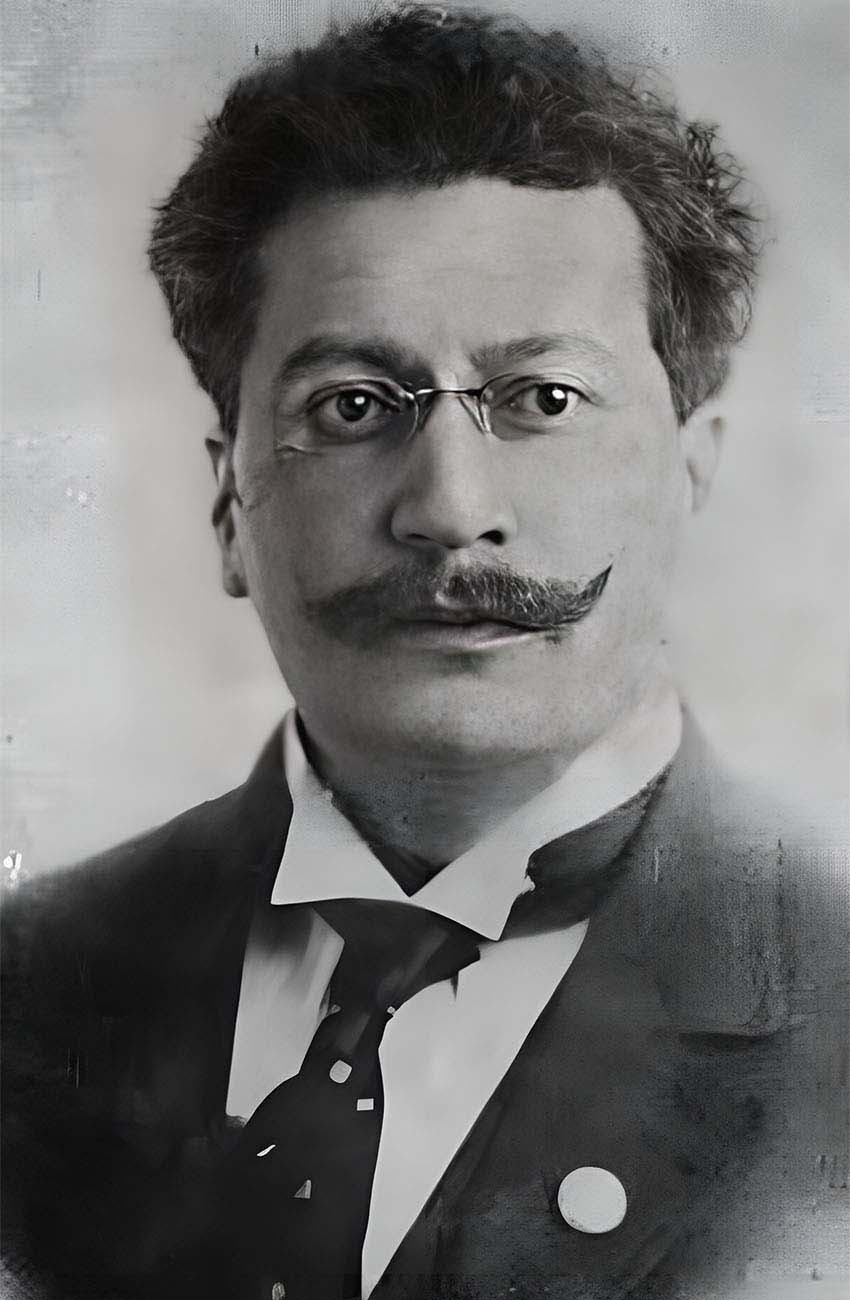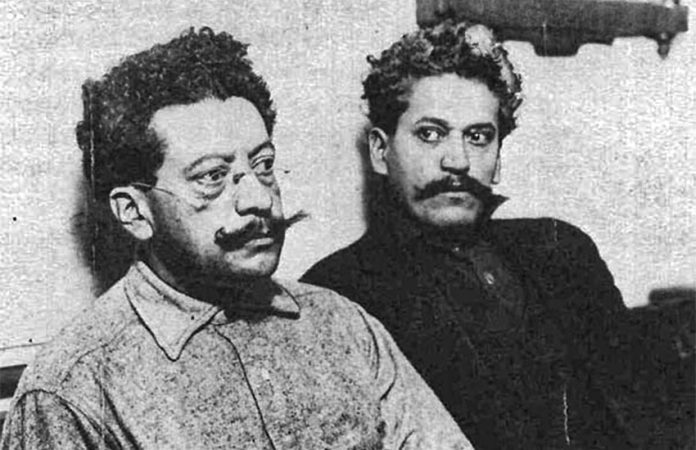One hundred years after the death of the pioneering Mexican revolutionary Ricardo Flores Magón, his story is finding new resonance and visibility in Mexico, thanks in part to Mexican president Andrés Manuel López Obrador’s decision to evoke the revolutionary movement Flores Magón founded, the Magonistas, in the Morena Party’s National Development Plan.
The Morena Party’s explanations of its National Development Plan, its plan to transform the country during AMLO’s term, cites Flores Magón and his historic 1906 revolutionary manifesto for The Mexican Liberal Party as inspiration for its plan for the country. The document influenced Mexico’s constitution of 1917 after the overthrow of notorious Mexican president and dictator Porfirio Díaz, who was eventually overthrown in 1911.
UCLA historian Kelly Lytle Hernández, whose 2022 book about Magón, “Bad Mexicans: Race, Empire & Revolution in the Borderlands,” made The New Yorker magazine’s list of the year’s best so far, says Magón’s history has been relatively forgotten until recently, and certainly outside Mexico it remains forgotten, despite the fact that he greatly influenced his more famous fellow revolutionaries and was even briefly offered the vice-presidency of Mexico.
Although he was an early revolutionary, Flores was self-exiled in the U.S. for much of the active fighting in Mexico, pursuing the overthrow of Díaz from the Mexico-U.S. borderlands. Yet, he was seen as enough of a threat by both the U.S. and the Mexican government that they pursued him together in the years leading up to the Mexican Revolution.

Lytle says she grew up in those borderlands, knowing nothing about Magón and his importance in both Mexico and the U.S., where he became involved in the anarchist movement.
“Across the border, that legacy, that story, has been stopped short for many years. Nobody talked about the Magonistas,” she said. “I felt almost robbed and cheated that no one told me about these people in my own country. They changed the history of the U.S. and Mexico, if not the world.”
Flores Magón launched a series of raids against Díaz from the U.S., which sparked an extraordinary manhunt for him. During U.S. president Theodore Roosevelt’s administration, the Departments of Justice, State, Treasury and War all got involved in the search for him and the Magonistas.
Even the U.S. Postal Service was involved, as was a new agency, which played a leading role – the Bureau of Investigation, the forerunner of the FBI.
“It was possible for [the Postal Service], U.S. government spies and consular officials to open up rebel mail, anticipate the next act of armed resistance and follow [the Magonistas] across the country, arresting, kidnapping and deporting as many as possible,” Hernández said.
Flores Magón’s tale is rooted in the Mexican-American War, when the victorious U.S. annexed about half of historical Mexico in the Treaty of Guadalupe Hidalgo. U.S. Anglo settlers subsequently laid claim to the land, dispossessing Mexican, Mexican-American and indigenous populations. It set a precedent that still remains today: Mexican laborers began migrating seasonally for low-paying, dangerous work on farms and ranches in the American Southwest, subject to segregation that was nicknamed “Juan Crow” – a twist on the racist Jim Crow laws against Black citizens in the American South.
South of the border, military leader Díaz had seized power in 1876 and seemingly achieved his desired goals of order and progress for Mexico following decades of unstable governments dating back to its independence. And yet, as the book indicates, this came at a cost: Díaz monopolized power and stifled dissent; the progress of a modernized economy occurred through favorable deals with international companies and governments, with a heavy U.S. influence. The Mexican public, the book states, suffered from economic dislocation and low wages at the hands of American business owners.
This was the climate into which the Flores Magón brothers – Jesús, Ricardo and Enrique – came of age. A law school dropout, Ricardo started a subversive newspaper named Regeneración and after covering the founding of the dissident political party the Partido Liberal Mexicano (PLM) in 1901, he and his brothers joined and became active members. The group sought not only the overthrow of Díaz but also to take Mexico’s land back to ensure economic freedom for the common people.

Unlike other dissidents who were fighting Diaz’s rule, Ricardo called the president by name in his writings. It would be a fateful choice.
Arrest and prison time soon followed. By 1904, the young journalist felt compelled to flee to the U.S. with younger brother Enrique after the Díaz government banned publication of his writings. In the U.S., he reestablished Regeneración and established a U.S. branch of the PLM made up of a diverse group of revolutionaries. The PLM’s Liberal Plan of 1906 contained many ideas later incorporated into Mexico’s 1917 constitution.
“Ricardo Flores Magón was the intellectual leader of the social movement,” Lytle said. “He was among the most radical of the voices.”
What distinguished Flores Magón from other opponents of Díaz was his turn from socialism to anarchism, which appears to have been influenced by his time in the U.S. — and which helped make him a target of the U.S. government as well as the Mexican.
Lytle suggests that other immigrant anarchists who were in the U.S. at this time – notably Emma Goldman – had an influence on him, one that he sometimes downplayed. “It was dangerous in the early 20th-century U.S. to be an immigrant anarchist,” Lytle said. “You could be deported after 1903. Emma Goldman would go on to be deported.”
Flores Magón built up enough support to launch four separate raids against the Díaz regime from Texas between 1906 to 1908. The deadliest one, in June 1908, prompted the involvement of the Bureau of Investigation. “The original intent [of the Bureau of Investigation] was largely [to investigate] land fraud across the American West,” Lytle noted. “Once there was the raid, Roosevelt and the Department of Justice pivoted. They could not ignore it.”
The book also chronicles an increasingly hostile climate on both sides of the border, including the death of a young ranch hand named Antonio Rodríguez in a 1910 lynching by white Texans – a frequent atrocity in the borderlands in that era. Rodríguez’s death sparked extensive anti-American riots in Mexico. When the U.S. government protested the riots, Díaz blamed Flores Magón and a convenient target: the dictator’s rival in that year’s presidential election, Francisco Madero, who had fled northward after a suspicious election loss and was calling for popular revolt against Díaz.
When the revolution finally began in 1910, Flores Magón was initially offered the vice presidency in a Madero administration. However, the Magonista leader alienated Madero — as well as others in the revolutionary movement — with his embrace of anarchy. Madero ended up defeating the Magonistas in Baja California en route to claiming the presidency in 1911.

From the U.S., Flores Magón had to watch other revolutionaries take center stage in the fight to take back Mexico. Still, he had an impact.
One prominent revolutionary, Emiliano Zapata, had been reading Regeneración as early as 1906, says Lytle. Zapata’s famous slogan that he carried on a banner into battle, tierra y libertad (land and liberty), was a Magonista slogan.
So why did Flores Magón’s achievements slide into obscurity? Well, for one thing, he did not live out the rest of his days in Mexico, but rather in U.S. jail at Fort Leavenworth, Kansas, where he died in 1922.
“When I give talks,” Lytle said, “often the first questioner says, ‘It left me in tears. I never had the opportunity to learn this history.’ They did not know why their grandparents came here, their great-grandparents, their parents. They get a better context with their family’s experience in Mexico and the U.S. … The impact has been extraordinary for many readers.”
Rich Tenorio is a frequent contributor to Mexico News Daily.
